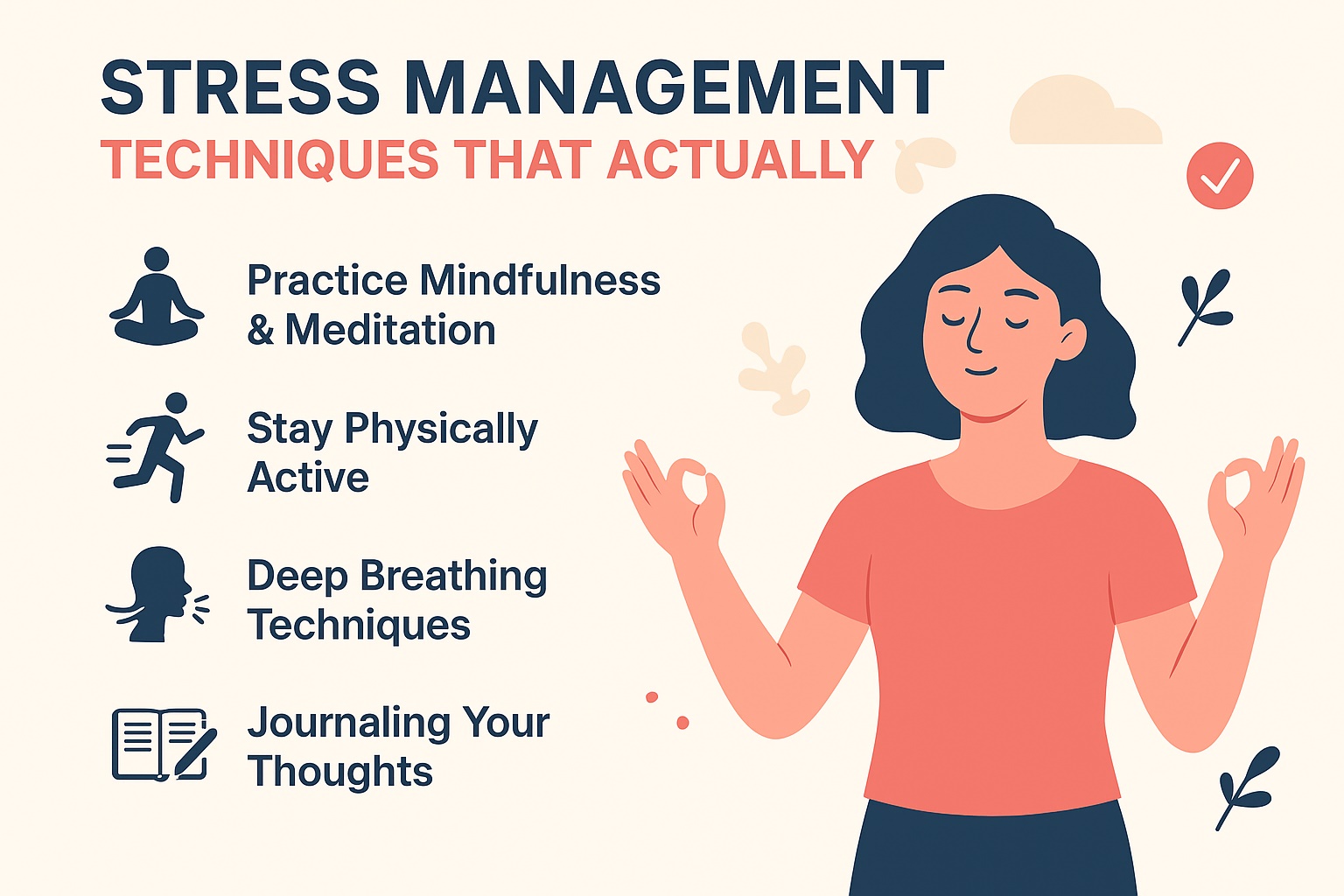Introduction
Stress is part of life, showing up at work, at home, and in daily tasks. If you ignore it, the effects can harm both your mind and your body. Fortunately, you can use clear and proven stress management techniques to feel better and stay steady.
This guide is easy to follow. In fact, you will learn how to calm your mind and relax your body. You will also see small steps you can try today. Each tip is short, practical, and friendly. As a result, you will build healthy habits that last.
Begin with one method and keep it simple. Later, you can add another when you feel ready. Over time, these tools can change how you think, act, and rest. Most of all, they can help you feel safe and in control again.
Stress Management Techniques: Mindfulness and Meditation
Mindfulness means paying attention to the present moment. You notice your breath, your thoughts, and your feelings without judgment. As a result, this soft focus can lower stress and reduce racing thoughts.
Meditation is a simple way to practice mindfulness. For example, sit in a quiet spot and set a timer for five or ten minutes. Close your eyes and breathe slowly. When your mind wanders, gently bring it back to your breath. That is the whole skill.
Here is a quick routine you can try today:
- Sit tall, but keep your shoulders loose.
- Inhale through your nose. Exhale through your mouth.
- Count the breaths from one to ten, then start again.
- When thoughts appear, label them “thinking” and return to breathing.
Start small and practice daily. Over time, your focus grows and your mood improves. Consequently, stress feels lighter because you respond with calm, not panic.
Stress Management Through Exercise and Physical Health
Movement helps your brain and your body. Exercise releases feel-good chemicals, which lift your mood and reduce tension. You do not need a gym to start because even a short walk is enough.
Try this simple plan:
- Walk for ten minutes after lunch or dinner.
- Do gentle stretches in the morning.
- Add two body-weight moves: squats and wall push-ups.
- Choose one fun activity each week: dancing, cycling, or yoga.
Keep your goals realistic. Small, steady steps beat extreme plans. If you miss a day, simply start again the next day. Consistency is the key. After a few weeks, your energy rises, your sleep gets better, and stress drops.
Related Reading: Explore our guide on Best Weight Loss Apps That Actually Work.
3. Deep Breathing Techniques
Slow breathing tells your body that you are safe. As a result, your heart rate drops, your muscles relax, and your mind feels clear. You can use breathwork anywhere, even during a busy day.
Try the 4-7-8 method:
- Inhale through your nose for 4 counts.
- Hold your breath for 7 counts.
- Exhale through your mouth for 8 counts.
- Repeat four times.
Another option is box breathing:
- Inhale 4 counts. Hold 4. Exhale 4. Hold 4.
- Trace a mental square as you breathe.
Use these tools before a meeting, during traffic, or at bedtime. In just a few minutes, your body will calm down, your thoughts will slow, and your stress will ease.
4. Journaling Your Thoughts
Writing is a safe way to release worry. It helps you name your feelings and see patterns. Moreover, it gives you space to plan your next step. You do not need perfect grammar. You only need honesty.
Here are three journal prompts:
- “Right now, I feel… because…”
- “One small thing I can control today is…”
- “Three good things that happened today were…”
Set a timer for five minutes and write without stopping. Do not edit. When the timer ends, close the notebook. You will feel lighter. With practice, you will react with clarity, not fear.
6. Eat a Balanced Diet
Food affects mood. As a result, stable blood sugar helps you think clearly and stay calm. Choose simple, whole foods most of the time. Aim for color and variety on your plate.
Here is a calm-energy checklist:
- Eat protein with each meal: eggs, yogurt, beans, or fish.
- Add fiber: oats, brown rice, fruits, and vegetables.
- Drink water often. Keep a bottle at your desk.
- Limit sugar and large amounts of caffeine.
Perfection is not required. Use the “better, not perfect” rule. Instead of changing everything at once, choose one small upgrade at a time. Your body and your brain will thank you.
7. Prioritize Quality Sleep
Sleep is your stress reset. Moreover, during sleep, your brain clears waste and restores balance. Good sleep supports memory, mood, and focus. Poor sleep raises anxiety and irritability.
Build a bedtime routine:
- Go to bed and wake up at the same time daily.
- Dim lights one hour before bed.
- Avoid screens in that last hour. Read or stretch instead.
- Keep your room cool, dark, and quiet.
If you cannot sleep, try this: get out of bed and sit in a chair. Then read a page or two. Return to bed when you feel sleepy. This breaks the “stress in bed” loop and trains your brain to relax.
FAQs on Stress Management
What are the best stress management techniques?
Start with breathwork, a short walk, and a simple journal prompt. In addition, add a five-minute meditation. These small steps work well together. They are easy to repeat each day.
Can stress be completely eliminated?
No. Stress is part of life. However, you can manage it. Use simple tools to reduce the intensity and the length of stress. Over time, you will bounce back faster.
Is exercise effective for stress relief?
Yes. Even ten minutes can help. Movement lowers tension and lifts mood. Therefore, choose an activity you enjoy so you can stick with it.
How does meditation help in stress management?
Meditation trains your attention. It slows racing thoughts and eases worry. With practice, you stay calm during challenges.
Can diet impact stress levels?
Yes. Balanced meals support steady energy and a stable mood. For best results, focus on protein, fiber, and water while limiting large sugar spikes.
How can I manage stress at work?
Use short breaks. Breathe slowly before meetings. Keep a simple to-do list with three key tasks. Moreover, protect your focus with quiet time blocks.
Does sleep affect stress levels?
Yes. Quality sleep reduces stress hormones. Build a calm bedtime routine. In addition, keep your room cool and dark for better rest. Stress Management Techniques
For more scientific insights, check this Healthline guide on stress management.
For more scientific insights, check this Healthline guide on stress management.




5. Build Strong Social Connections
Stress grows in isolation but shrinks when you feel supported. A short call with a friend can help, and an honest chat with family can help too. Sharing your feelings does not make you weak. On the contrary, it makes you human.
To build support, try this plan:
Strong ties boost resilience. When you feel seen and heard, stress has less power. Connection is a skill; therefore, practice it often.